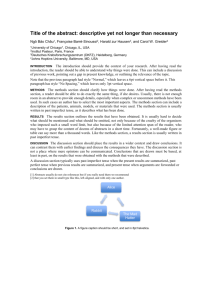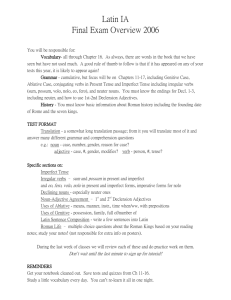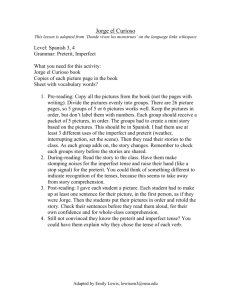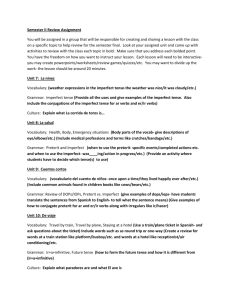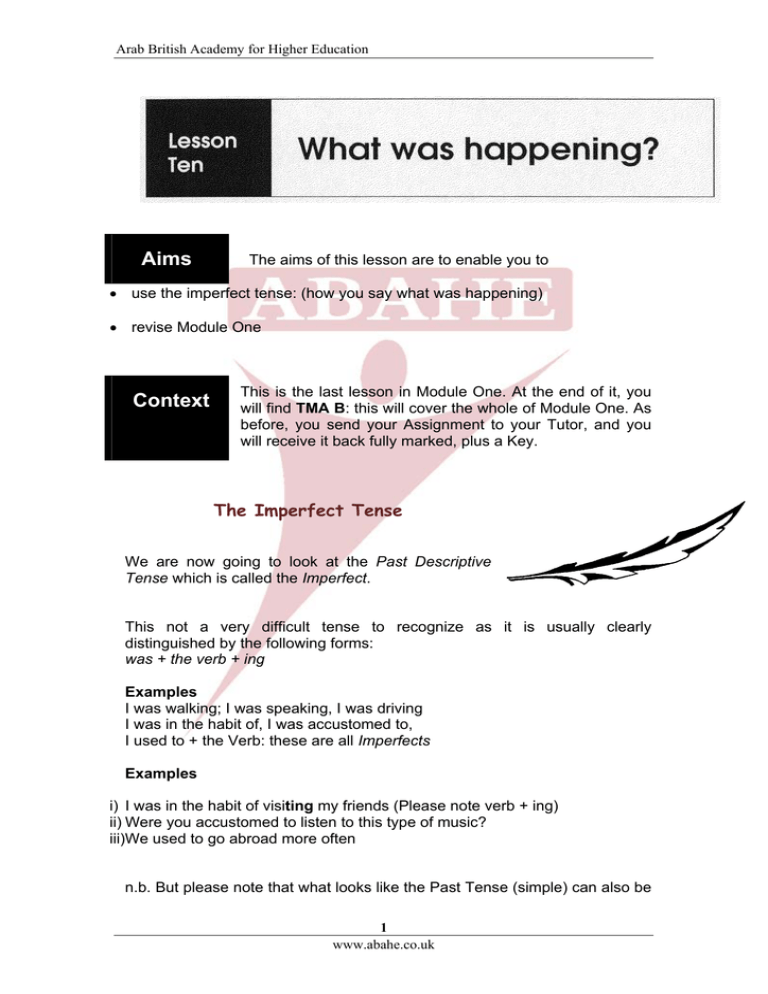
Arab British Academy for Higher Education
Aims
The aims of this lesson are to enable you to
use the imperfect tense: (how you say what was happening)
revise Module One
Context
This is the last lesson in Module One. At the end of it, you
will find TMA B: this will cover the whole of Module One. As
before, you send your Assignment to your Tutor, and you
will receive it back fully marked, plus a Key.
The Imperfect Tense
We are now going to look at the Past Descriptive
Tense which is called the Imperfect.
This not a very difficult tense to recognize as it is usually clearly
distinguished by the following forms:
was + the verb + ing
Examples
I was walking; I was speaking, I was driving
I was in the habit of, I was accustomed to,
I used to + the Verb: these are all Imperfects
Examples
i) I was in the habit of visiting my friends (Please note verb + ing)
ii) Were you accustomed to listen to this type of music?
iii)We used to go abroad more often
n.b. But please note that what looks like the Past Tense (simple) can also be
1
www.abahe.co.uk
Arab British Academy for Higher Education
Imperfect depending on the situation
This is more difficult because although the verb looks like the Past Tense
(single Action,) its meaning can be quite different; you have to examine the
sentence carefully... More details of this are given below.
Examples
We went every year to Mallorca (Imperfect)
The car bumped into me (single action), as I came out of the side turning
(Imperfect)
The Meaning and Purpose of the Imperfect
To understand fully the Imperfect, you have to understand its real meaning
which is incomplete, as opposed to Perfect which means complete... e.g. a
perfect specimen is a complete specimen...
So if the past action is incomplete in the sense of repeated, continuous, or
descriptive, the tense will be imperfect, regardless of the words used. Often
the imperfect is easy to recognize as the verb form is clear, but there are
times when it is more difficult if it takes the form of a single word. In that sort
of situation, it is only the context that can make clear the tense (See the
examples...)
The purpose of the Imperfect is basically to set the scene. It is a background
tense that says what used to happen, what was happening, but does not
advance the action of any narrative.
The other main past tenses, whether the Past Simple or the Present Perfect,
do advance the action, telling the story, and describing what happened. Here
are some examples to show how the Imperfect and the Past Simple are
used. There will be an Activity on this, but not till the end of this Lesson. The
first Activity will be revision, based on Lesson One...
The sun was shining, (Imperfect descriptive) when Elizabeth woke up (Past Simple)
Every evening Peter went (Imperfect, repeated action) to his music lesson
I knew (imperfect past state) that he was wrong (past state)*
We used to go (imperfect) to the pictures, but the expense stopped (Past simple,
narrative) us in the end
* Past state means there was nothing actually happening; the verb is still...
e.g. The ground vas covered with snow
I believed he would come
2
www.abahe.co.uk
Arab British Academy for Higher Education
All Rights Reserved © Arab British Academy for Higher Education
3
www.abahe.co.uk



